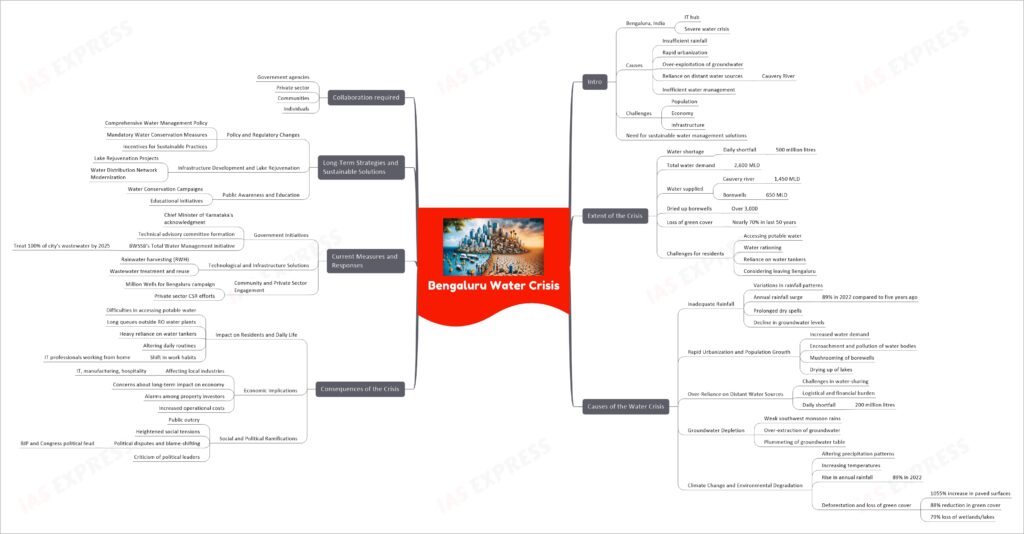[In-depth] Bengaluru Water Crisis – Causes, Effects, Measures

Bengaluru, India’s burgeoning IT hub, is grappling with a severe water crisis, exacerbated by insufficient rainfall, rapid urbanization, and over-exploitation of groundwater resources. The city’s reliance on distant water sources, such as the Cauvery River, and inefficient water management practices have further compounded the problem. This crisis poses significant challenges to the city’s population, economy, and infrastructure, highlighting the urgent need for sustainable water management solutions.
Extent of the Bengaluru Water Crisis
- Bengaluru is facing a severe water shortage, with a daily shortfall of 500 million litres.
- The city’s total water demand is approximately 2,600 MLD, with only 1,450 MLD being supplied from the Cauvery river and 650 MLD from borewells.
- Over 3,000 borewells have dried up, exacerbating the crisis.
- The city has seen a significant loss of nearly 70% of its green cover in the last 50 years, further aggravating the water shortage.
- Residents are facing challenges in accessing potable water, leading to water rationing and reliance on water tankers. Some are considering leaving Bengaluru temporarily due to the severity of the crisis
Causes of the Water Crisis
- Inadequate Rainfall
- Bengaluru has experienced variations in rainfall patterns, with instances of both deficit and excess rainfall over the years.
- The city’s annual rainfall surged by 89% in 2022 compared to five years ago, indicating significant variability.
- Despite this increase, prolonged dry spells due to weak monsoons have put the groundwater table under tremendous stress, leading to a sharp decline in groundwater levels across various taluks of Bengaluru Urban district.
- Rapid Urbanization and Population Growth
- Bengaluru’s rapid urbanization and population growth have significantly increased water demand.
- The city’s expansion has led to the encroachment and pollution of natural water bodies, exacerbating the water crisis.
- Urban experts highlight the mushrooming of borewells and drying up of lakes as main reasons behind the crisis, with almost half of the city’s water demand met by groundwater.
- Over-Reliance on Distant Water Sources
- The city’s heavy reliance on the Cauvery River for more than 70% of its water supply poses challenges in water-sharing and creates a logistical and financial burden.
- The dependence on distant water sources has led to a daily shortfall of 200 million litres in water supply due to depleted groundwater levels and the need for deeper borewells.
- Groundwater Depletion
- Weak southwest monsoon rains have led to depleted groundwater levels and reduced water levels in the Cauvery River basin reservoirs.
- The over-extraction of groundwater for potable purposes and other activities has resulted in the plummeting of the groundwater table, which had been recharged in the past decade.
- Climate Change and Environmental Degradation
- Climate change is altering precipitation patterns and increasing temperatures, contributing to the water crisis in Bengaluru.
- The city has seen an 89% rise in its annual rainfall in 2022 compared to five years ago, which could be attributed to the impact of climate change.
- Additionally, deforestation and loss of green cover have led to a more than 1055% increase in paved surfaces, with an 88% reduction in green cover and a 79% loss of wetlands/lakes, reducing groundwater recharge.
Consequences of the Crisis
- Impact on Residents and Daily Life
- Residents of Bengaluru are facing severe difficulties in accessing potable water, leading to long queues outside RO water plants and heavy reliance on water tankers due to groundwater depletion and the drying up of over 3,000 borewells.
- The crisis has forced many to alter their daily routines, with some residents considering leaving the city as the water crisis severely impacts their daily lives, highlighting the struggle to perform basic household tasks and the high costs associated with securing water.
- The water shortage has also prompted a shift in work habits, with many IT professionals opting to work from home to save water and avoid the inconvenience caused by the lack of water in offices, reflecting the broader impact of the water crisis on the daily lives and routines of Bengaluru’s residents.
- Economic Implications
- The water crisis is adversely affecting local industries, with sectors like IT, manufacturing, and hospitality facing significant challenges.
- Industries dependent on regular water supply for day-to-day operations are bearing the brunt of the crisis, leading to concerns about the potential long-term impact on Bengaluru’s economy and its reputation as India’s Silicon Valley.
- The situation has raised alarms among property investors, indicating a possible long-term impact on investment and business operations in the city.
- The crisis has led to increased operational costs for businesses, as they are forced to purchase water at exorbitant rates from tankers, particularly dire for industries such as textiles and hospitality, which rely heavily on water for their operations, extending beyond the immediate industries affected, potentially impacting the broader economic landscape of Bengaluru.
- Social and Political Ramifications
- The water crisis has sparked a public outcry, with residents demanding immediate and effective action from the government to address the shortage.
- The situation has led to heightened social tensions, as the struggle for water access becomes increasingly desperate.
- The crisis has also prompted political disputes and blame-shifting between parties, with the BJP and Congress engaging in a political feud over the management of the water crisis, accusations of mismanagement and failure to implement effective water management measures intensifying the political discourse surrounding the crisis.
- Political leaders have been criticized for their handling of the situation, with opposition parties accusing the government of negligence and mismanagement, leveraging the issue to criticize their opponents and push for policy changes, while the urgent need for collaborative efforts to tackle the water crisis remains a priority for the residents of Bengaluru.
Current Measures and Responses
- Government Initiatives
- The Chief Minister of Karnataka has acknowledged the water shortage in Bengaluru, quantifying the deficit at 500 million litres per day (MLD), with various measures undertaken, including the formation of a technical advisory committee to prevent future crises.
- The Bangalore Water Supply and Sewerage Board (BWSSB) aims to treat 100% of the city’s wastewater by 2025 for reuse, as part of its Total Water Management initiative, focusing on the cyclical use of water in Bengaluru’s urban waterscape.
- Technological and Infrastructure Solutions
- Rainwater harvesting (RWH) is highlighted as a crucial method to address water scarcity, capturing rainwater that would otherwise run off of paved surfaces and flood the streets.
- Wastewater treatment and reuse are emphasized as important parts of the solution to Bengaluru’s water situation, with a focus on the reuse of treated wastewater for non-potable purposes to reduce the demand for fresh water.
- Community and Private Sector Engagement
- Community initiatives like the Million Wells for Bengaluru campaign aim to engage citizens in groundwater recharge efforts, crucial for raising awareness and mobilizing community action towards sustainable water management practices.
- The private sector is also playing a role in addressing the water crisis through corporate social responsibility (CSR) efforts and private contributions, with companies increasingly involved in water management projects to develop and implement solutions that can alleviate water scarcity in Bengaluru.
I’m unable to access or retrieve information from external websites or databases directly in real-time, including the sources you’ve provided. However, I can generate a response based on the information available up to my last update. Here’s an overview of potential long-term strategies and sustainable solutions for water management, particularly relevant to urban areas like Bengaluru:
Long-Term Strategies and Sustainable Solutions
Policy and Regulatory Changes
- Comprehensive Water Management Policy: There’s a critical need for a holistic water management policy that addresses the entire water cycle, from supply and distribution to wastewater treatment and reuse. This policy should integrate climate resilience and sustainability principles to ensure water security for future generations.
- Mandatory Water Conservation Measures: Implementing mandatory water conservation measures can significantly reduce water wastage. This includes regulations for industries, commercial establishments, and residential areas to adopt water-saving technologies and practices.
- Incentives for Sustainable Practices: Offering incentives for adopting sustainable water practices, such as rainwater harvesting, greywater recycling, and the installation of water-efficient fixtures, can encourage wider adoption among the public and private sectors.
Infrastructure Development and Lake Rejuvenation
- Lake Rejuvenation Projects: Rejuvenating and managing the city’s lakes can enhance water storage and recharge groundwater. This involves desilting, restoring feeder channels, and preventing pollution and encroachment of lakes.
- Water Distribution Network Modernization: Expanding and modernizing the water distribution network is essential to reduce losses and ensure equitable water distribution. This includes replacing old and leaky pipes and implementing smart water management systems to monitor and control water flow.
Public Awareness and Education
- Water Conservation Campaigns: Launching public awareness campaigns about the importance of water conservation and responsible usage can change public attitudes and behaviors towards water. These campaigns can utilize various media platforms to reach a broad audience.
- Educational Initiatives: Integrating water sustainability concepts into the educational curriculum can foster a culture of water stewardship from a young age. Workshops, seminars, and interactive learning experiences can promote understanding and engagement in water conservation efforts.
These long-term strategies and sustainable solutions require the collaboration of government agencies, the private sector, communities, and individuals to effectively address the water crisis and ensure water security for future generations.
Conclusion
The water crisis in Bengaluru underscores the urgent need for comprehensive and sustainable water management strategies. Addressing the crisis requires a multifaceted approach, including government intervention, technological innovation, community engagement, and private sector participation. Effective measures such as rainwater harvesting, wastewater treatment, and infrastructure development must be prioritized to ensure the city’s resilience against future water scarcity challenges.
Practice Question
Evaluate the effectiveness of Bengaluru’s current strategies to combat its severe water crisis. Suggest innovative solutions for sustainable water management in urban areas. (250 words)
If you like this post, please share your feedback in the comments section below so that we will upload more posts like this.


